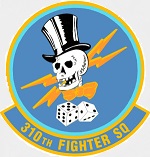Hobby Master HA38012 USAF General Dynamics F-16D Viper Fighter - 90-0778, 310th Fighter Squadron "Top Hats", Luke AFB, Arizona, June 2022 (1:72 Scale)
"Obsolete weapons do not deter."
- British Prime Minister Margaret Thatcher
 Even at the ripe old age of 20, the F-16 Falcon remains a fast and potent favorite among fighter pilots, and one of the best fighters in its class. Designed originally as a no-frills, single-engine "hot rod", the addition of improved radar and weaponry have made the Falcon a super, lightweight jet. Used mainly as a bomber, the Fighting Falcon can also turn-and-burn with unbridled fury when provoked. It is also one of the first operational fly-by-wire aircraft; its flight controls being electronically operated and computer controlled. A 20mm cannon, Maverick missiles, and laser-guided bombs make the F-16 a potent multi-role fighter. However, it's light weight, speed and agility make it the choice of the US Air Force's Thunderbirds aerobatic team.
Even at the ripe old age of 20, the F-16 Falcon remains a fast and potent favorite among fighter pilots, and one of the best fighters in its class. Designed originally as a no-frills, single-engine "hot rod", the addition of improved radar and weaponry have made the Falcon a super, lightweight jet. Used mainly as a bomber, the Fighting Falcon can also turn-and-burn with unbridled fury when provoked. It is also one of the first operational fly-by-wire aircraft; its flight controls being electronically operated and computer controlled. A 20mm cannon, Maverick missiles, and laser-guided bombs make the F-16 a potent multi-role fighter. However, it's light weight, speed and agility make it the choice of the US Air Force's Thunderbirds aerobatic team.
The F-16C (single seat) and F-16D (two seat) variants entered production in 1984. The first C/D version was the Block 25 with improved cockpit avionics and radar which added all-weather capability with beyond-visual-range (BVR) AIM-7 and AIM-120 air-air missiles. Block 30/32, 40/42, and 50/52 were later C/D versions. The F-16C/D had a unit cost of US$18.8 million (1998). Operational cost per flight hour has been estimated at $7,000 to $22,470 or $24,000, depending on calculation method.
Pictured here is a gorgeous 1:72 scale diecast replica of a USAF General Dynamics F-16D Viper fighter that was attached to the 310th Fighter Squadron "Top Hats", then deployed to Luke AFB, Arizona, during June 2022.
Sold Out!
Dimensions:
Wingspan: 7-inches
Length: 8-inches
Release Date: April 2023
 Historical Account: "Top Hats" - The 310th Fighter Squadron is part of the 56th Operations Group at Luke Air Force Base, Arizona. It operates the General Dynamics F-16 Fighting Falcon aircraft conducting advanced fighter training.
Historical Account: "Top Hats" - The 310th Fighter Squadron is part of the 56th Operations Group at Luke Air Force Base, Arizona. It operates the General Dynamics F-16 Fighting Falcon aircraft conducting advanced fighter training.
The unit, which adopted its original "Tophat" name in September 1987, has earned two Distinguished Unit Citations, Philippine Presidential Unit Citation, Republic of Korea Presidential Unit Citation, and nine Air Force Outstanding Unit Awards.
During the late 1990s with the growing use of night vision goggles the 310th has become the principle trainer in this role. It was several years later that the squadron began training night-vision goggle qualified pilots. Although now well known for night vision training, the 310th FS is also tasked with other pilot training normally in the realms of advanced pilot training. One such program is Forward Air Controller, of which the 310th FS is currently the only squadron in the USAF that trains F-16 pilots in this role. Each class lasts five weeks and includes twelve sorties intended to test technical knowledge of the program. The 310th Fighter Squadron on average graduates thirteen classes of FAC qualified pilots a year.
Beginning in April 2004 the 310th FS was tasked with all night vision goggle training. Pilots going through this training program have to be experienced as the night vision goggles prove to be very challenging. New pilots to the training program have known to follow stars in the sky thinking they are following their flight leader. In bad weather the goggles can be useless as they depend on some source of light. A common training element is to have students fly in a four ship formations on a strike mission having to fight their way in and out against enemy aggressors. In all, a trainee will face three to four weeks of training using the goggles including simulator time and eight sorties in the real jet. Although it fluctuates, the school often turns out 150 night vision goggle trained pilots a year.


